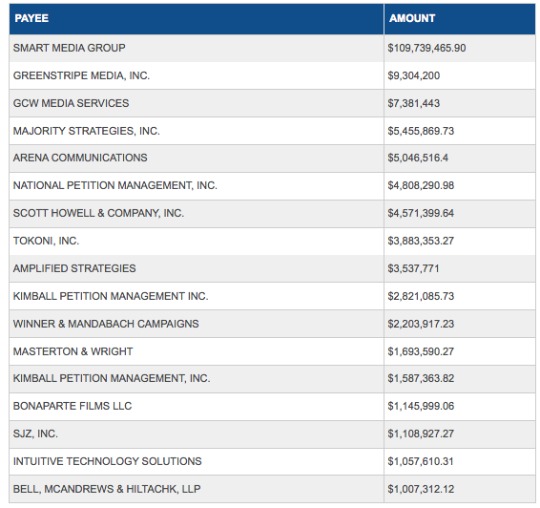Much has been written this election cycle about all the self-funded business-background candidates who stepped into the campaign fray, checkbooks at the ready. There was Carly Fiorina in California’s Senate race, Feingold-slaying Ron Johnson in Wisconsin, and primary losers like Jeff Greene in Florida. But California gubernatorial candidate Meg Whitman—the former eBay CEO known as eMeg in the state’s press—has gotten the lion’s share of attention for signing the lion’s share of the checks. Whitman spent $160 million on her campaign, $141.4 million of that coming from her own wallet.
A lot of the coverage on Whitman has consisted of reporters marveling at the size of her coffers, particularly around September, when she leapfrogged New York City mayor Michael Bloomberg to become the most highly self-financed political candidate in the nation’s history. Then, when polls showed pretty clearly that money was buying her no love towards the end of October, the media read changed across the board to reflect just that: money, it turns out, doesn’t always win elections. Whitman’s opponent, Jerry Brown, spent a relatively meager $24.8 million on his way to Schwarzenegger’s mansion.
And there has been some fun math in the aftermath of Tuesday’s California vote. It turns out Whitman paid $46 per vote she received.
The question that has gone largely unanswered among the reports following the big eMeg narratives is the question of what exactly Whitman has been doing with all that ineffective cash. How does a political candidate spend $160 million dollars? And whom is she giving it to?
This week, nonprofit investigative outfit California Watch has been providing answers. First, former San Francisco Chronicle writer Lance Williams pored through expenditure reports filed with the California secretary of state’s office to show what Whitman’s dollars bought her.* His piece, which was widely co-published, opened with a smashing lede:
There were the fundraisers at the U.S. Grant Hotel in San Diego (cost to stage: $71,000), the Beverly Hilton in Beverly Hills ($42,900), the Bernardus Lodge & Winery in Carmel Valley ($20,564), and the Princeton and Harvard clubs in New York City ($12,300 combined).
Then there were the private flights aboard ACM Aviation’s corporate aircraft ($961,000), the legal bills from the Sacramento firm of Bell, McAndrews & Hiltachk ($845,000), and the donation to the state Republican Party ($248,000).
Tack on $11.6 million for political consultants, $10.5 million for mail and an astonishing $106.9 million for broadcast advertising, and you get an idea of how Meg Whitman spent more than $160 million – most of it her own money – on her campaign for governor of California.
In the same report, California Watch provides a table showing how much Whitman and Brown each spent on different elements of their campaign, from TV and radio advertising to campaign worker salaries. It’s pretty predictable stuff—the bulk of the cash went to broadcast advertising, as noted above—but an interesting insight nonetheless into the machinations of a campaign that swallowed and spat out such a huge amount of cash.
California Watch’s Chase Davis follows that report up today with a look at how losing campaigns in California—Whitman’s, Fiorina’s, as well as campaigns for and against initiatives, and for lower offices—spent a combined $225 million. (And likely more, as Davis writes that he is working from figures through mid-October, before the final onslaught.)
The focus here is not on the candidates but on the businesses that benefited from their dollar-fueled ambition.
Here in California, the biggest winners among the losers have been media buyers, campaign consultants and signature-gathering firms. In all, at least 17 firms made $1 million or more working on losing efforts….
…Not surprisingly, many of the largest payouts went to the consulting team behind gubernatorial candidate Meg Whitman. The $109 million-plus she spent on ad buys through DC-based Smart Media Group accounted for nearly half of the money spent on all losing statewide bids combined (not including the attorney general’s race, which is still too close to call).
Media planner and buyer Smart Media Group counts among its clients the Department of Homeland Security and the RNC.
In the same report, California Watch provides this table, showing who earned what as the candidate’s spent their way to losses.

While noting that the money spent on losing ballot measures was modest compared to what has been spent in previous years, Davis also shows where the $44 million was spent in unsuccessful pro and anti initiative campaigns. And some of it is surprising (at least to me, who always thought signature drives occurred at bakesales!)
Still, signature-gathering firms made millions. National Petition Management, Inc., one of the country’s largest signature-gathering firms, made more than $4.8 million working to qualify at least four ultimately failed ballot measure campaigns: Props. 23, 24, 25 and 27. Kimball Petition Management also walked away with more than $4.4 million.
This is good hole-filling work from California Watch. In an article I wrote about the shrinking Sacramento press corps last month, I praised Watch for its reporting, but noted that it “doesn’t seem to have the resources to do the kind of projects the print bureaus produced in their heyday.” I should have added that Watch is giving us a lot of with its limited resources. By taking the time to pore through Whitman’s and other big-spending campaigns’ finances, they have provided insight into an industry—elections—that doesn’t like to reveal much about itself beyond the surface. And they’ve answered the question that’s been bugging some of us since Whitman’s poll dip: Just how do you spend $160 million to not get elected?
*Correction: the post originally, and incorrectly, stated that Williams formerly worked for the Sacramento Bee.
Joel Meares is a former CJR assistant editor.
